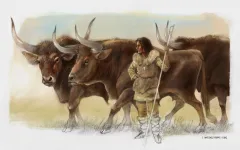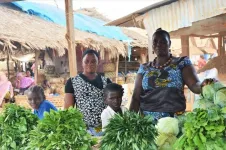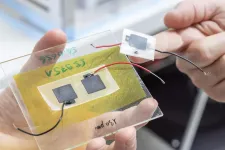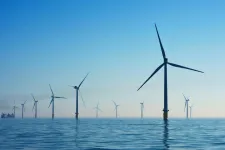(Press-News.org) Research involving scientists from the University of A Coruña has succeeded in sequencing the oldest mitochondrial genome of the immediate ancestor of modern cows that has been analysed to date. The remains, some 9,000 years old, were found next to a woman. Why were they with her if cattle had not yet been domesticated? Do they belong to ancestors of today's Iberian cows?
Humans have maintained a very close relationship with aurochs (Bos primigenius) since their beginnings, first by hunting them and then by breeding and selecting them.
This extinct species of mammal is little known in the Peninsula because its skeletal remains are difficult to distinguish from bison. In fact, there have been references to the presence of "large bovids" in many sites because they cannot be differentiated. At a European level, there is also a lack of genetic data.
An international team of scientists has managed to extract mitochondrial DNA from ruminants from different periods in Galicia. They have analysed the remains of B. primigenius from the Chan do Lindeiro cave (Lugo). These remains were found in a chasm together with the human fossils of the shepherdess of O Courel, "Elba", dated at around 9,000 years old. The aurochs analysed are not the oldest ones discovered, but they are the oldest ones whose mitochondrial DNA has been sequenced so far. Interestingly, although they were found together, they are genetically very different.
"Their discovery in the chasm together with a human is a great enigma. Given all the evidence, such as their similar chronology and the fact that the bones are intermingled at the base of a slump caused by the sinking of the ground -at a depth of 15 to 20 metres-, we think that the woman and the aurochs were found together. This interpretation is controversial because domestication is not regarded as having existed at the time," as Aurora Grandal, a researcher at the University of A Coruña and the co-author of the study published in the PLoS ONE journal, has explained to SINC.
The analysis of their mitochondrial DNA has not allowed these three aurochs to be related to the modern cows of the Peninsula. To investigate this possible relationship, the next step for the research team is to analyse the nuclear DNA.
Until now, different varieties of aurochs have been described, based on their morphology only. The three analysed in this study belong to haplogroup P, which is characteristic of the species. However, they differ from each other in a large number of base pairs [pieces that make up the genetic sequences], which is striking considering they are coeval. "This may indicate that they were from different origins, in a scenario in which the Elba woman played an active role; or a trait that simply reflected a very high genetic variability in the aurochs," says the researcher.
The origin of cattle domestication in the North
Domestic cattle were introduced into Spain by the first settlers and agricultural societies. Due to the absence of Neolithic sites in Galicia, very little is known about the process in this region.
To extract information about the introduction of this livestock in Galicia, researchers sampled 18 cattle fossils of different ages from different Galician mountain caves, of which eleven were subjected to mitochondrial genome sequencing and phylogenetic analysis.
The study of the three aurochs revealed their kinship with aurochs from other parts of Europe. "By studying their mitochondrial DNA, which is transmitted almost intact from mother to offspring, we can determine in which geographical areas the different lineages predominated and what their movements were due to changes in climatic conditions or even to humans following the onset of livestock farming," the palaeontologist and veterinarian Amalia Vidal, co-author of the study at the same university, tells SINC.
Thanks to the DNA, it is possible to know whether the native aurochs contributed to local livestock farming or, on the contrary, were imported animals, "with all the information that this provides about the movement of bovine and human populations," Vidal continues.
Her data show a close relationship between the first domesticated cattle in Galicia and modern cow breeds and provide an overview of cattle phylogeny. The results of the study indicate that settlers migrated to this region of Spain from Europe and introduced European cow breeds now common in Galicia.
Aurochs related to the British
"Specifically, these aurochs are more closely related to the aurochs of the British Isles than to the Central European specimens. British aurochs are more recent than those from Galicia. This may be related to the role of the Peninsula as a glacial refuge and the origin of the later recolonisation of the islands," Grandal points out.
These three coeval animals are small and have relatively short horns compared to those of northern Europe, and their morphology is different.
The researchers are now endeavouring to analyse the nuclear DNA of the three aurochs, which will allow them to learn about the possible contributions of these individuals to later domestic livestock. "For example, fragments of nuclear DNA from the British aurochs can be recognised in some breeds of northern European cows. This shows that there was a genetic contribution from aurochs to the already domestic cattle. We are going to look for possible contributions from our aurochs to Iberian cows, whether present-day or fossil," Grandal stresses.
In recent years, there has been a growing interest in the scientific community in learning about the origins of domestic animals, and there are a large number of projects to reconstruct their ancestors. One of the reasons for this is that these species are considered to be more rustic and with a better capacity to adapt to harsh environmental conditions.
"Early projects sought to generate phenotypes similar to the species they were trying to recreate (as was done with Heck cattle), but more modern projects also use DNA as a source of information," Vidal concludes.
Ancestors of bulls and cows
The social organisation of aurochs herds is assumed to have been similar to that of their domesticated bovine descendants: a single male who is relieved by another male as he weakens and his group of females.
The new males, when they reach adulthood, do not remain in the group, whereas the females do. In this way, it is normal for females of the same group to be related, which means that their mitochondrial lineages are similar.
The domestic cow comes from the domestication of the aurochs, albeit not in the Iberian Peninsula but in Asia, specifically in the Middle East, and from a small number of uses. This is the origin of the domestic cow, which then spread along with humans to occupy the whole of Europe.
In Italy, some researchers claim that the already domesticated cows had genetic contributions from local aurochs. The same holds for the British Isles. The contribution of local aurochs to cows is best observed in the nuclear DNA and was detected in some cases in northern European breeds.
In the north of the peninsula, the oldest domestic cows are about 7 to 6 thousand years old.
INFORMATION:
Interactions in the network can lower the critical temperature thresholds beyond which individual tipping elements begin destabilizing on the long-run, according to the study - the risk already increases significantly for warming of 1.5°C to 2°C, hence within the temperature range of the Paris Agreement.
"We provide a risk analysis, not a prediction, yet our findings still raise concern," says Ricarda Winkelmann, Lead of FutureLab on Earth Resilience in the Anthropocene at the Potsdam Institute for Climate Impact Research (PIK). "We find that the interaction of these four tipping elements can make them overall more vulnerable due to mutual destabilization on the long-run. The feedbacks between them tend to lower the critical temperature ...
A new study looking at the benefits of good farmer seed production suggests women need more support to participate in contract farming - to the same extent as their male counterparts - and have more equality along the whole food value chain.
The CABI-led research - which sought to assess the benefits of good farmer seed production through a case study of the Good Seed Initiative in Tanzania - reveals that while around 70% of the labour to grow African Indigenous Vegetables (AIVs) is provided by women only 10 to 30% are contract farmers who own the fields, make decisions on sales and control revenues.
The paper, led by Dr Monica Kansiime ...
Philadelphia, June 3, 2021 - Researchers at Children's Hospital of Philadelphia (CHOP) have demonstrated how to use standardized reporting of clinical data for seizures caused by a variety of neurological disorders, providing fundamental baseline information that can determine what methods work best for keeping seizures under control. The findings were published today in the journal Epilepsia.
In order to make improvements in epilepsy care, clinicians need a reliable and efficient method to measure outcomes. While Electronic Medical Records (EMR) are being used more frequently for research and quality improvement, important epilepsy outcome measures such ...
MUSC Hollings Cancer Center researchers are finding solutions to the aging-related changes that reduce anti-cancer immunity. Besim Ogretmen, Ph.D., and colleagues found a novel link between aging, metabolism and anti-cancer T-cell function. Their work, published in Cell Reports, sheds light on an important pathway that cannot be ignored during cancer treatment.
Two broad questions in cancer research are: How can cancer treatments be improved, and what is the link between cancer and aging?
"We know that the protective T-cell response deteriorates with age. Mitochondrial function is now thought to be one of the central regulators of the aging process. Our experiments connected the dots with what was previously shown and highlighted some ...
Thursday, June 3, 2021, CLEVELAND: A Cleveland Clinic study shows that survivors of COVID-19 who have moderate or severe obesity may have a greater risk of experiencing long-term consequences of the disease, compared with patients who do not have obesity. The study was recently published online in the journal of Diabetes, Obesity and Metabolism.
Multiple studies have identified obesity as a risk factor for developing a severe form of COVID-19 that may require hospital admission, intensive care, and ventilator support in the early phase of the disease. Obesity, which is a complex disease caused by multiple factors, is associated with an increased risk for cardiovascular ...
DURHAM, N.H.-- Bears are known for being devoted and protective of their baby cubs, but research from the University of New Hampshire shows that they may also play a significant role in shielding gray fox from predators like coyotes, who compete with the fox for food and space. The research is one of the first studies to show how black bears provide a buffer to allow other, smaller carnivores to safely co-exist.
"Even though black bears and coyotes are the two most common carnivores in North America, we're still learning how they affect the ecosystems around them," said Rem Moll, assistant professor of wildlife ecology and lead author ...
The fabrication device for the battery revolution looks quite unconspicuous: It is a modified, commercially available 3D printer, located in a room in the Empa laboratory building. But the real innovation lies within the recipe for the gelatinous inks this printer can dispense onto a surface. The mixture in question consists of cellulose nanofibers and cellulose nanocrystallites, plus carbon in the form of carbon black, graphite and activated carbon. To liquefy all this, the researchers use glycerin, water and two different types of alcohol. Plus a pinch of table salt for ionic conductivity.
A sandwich of four layers
To build a functioning supercapacitor from these ingredients, four layers are needed, all flowing out of the 3D printer one after the ...
Left- or right-handedness is a symmetry property that many macroscopic objects also exhibit and which is of immense importance, particularly for the bioactivity of organic molecules. Chirality is also relevant for physical or chemical properties such as optical activity or enantioselectivity of crystalline solids or their surfaces. In the case of chiral metallic phases, unconventional superconductivity and unusual magnetic ordered states are linked to the chirality of the underly-ing crystal structure. Despite this connection between chirality and the properties of a material, detection is often difficult because left-handed and righthanded ...
The expansion of wind energy in the German Bight and the Baltic Sea has accelerated enormously in recent years. The first systems went into operation in 2008. Today, wind turbines with an output of around 8,000 megawatts rotate in German waters, which corresponds to around eight nuclear power plants. But space is limited. For this reason, wind farms are sometimes built very close to one another. A team led by Dr. Naveed Akhtar from Helmholtz Zentrum Hereon has found that wind speeds at the downstream windfarm are significantly slowed down. As the researchers now write in the journal Nature Scientific Reports, this braking effect results in astonishingly large-scale low wind pattern noticeable in mean ...
Neurodegenerative disorders that cause dementia increase the risk of contracting severe COVID-19 and dying from the disease. For people with Alzheimer's the risk is three times greater. It can be six times greater if they are over 80, according to a study conducted in Brazil by researchers at the University of São Paulo (USP) and Butantan Institute in partnership with colleagues at the Federal University of Rio de Janeiro (UFRJ).
An article on the study, which was supported by FAPESP, is published in Alzheimer's & Dementia: The Journal of the Alzheimer's Association.
"We found that all causes of dementia are risk factors for severity and death in COVID-19 and that these ...





